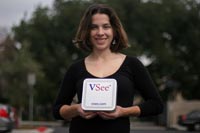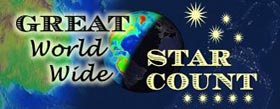Each month, the NSF Current newsletter highlights research and education efforts supported by the National Science Foundation. If you would like to automatically receive notifications by e-mail or RSS when future editions of NSF Current are available, please use the links below:
![]() Subscribe to NSF Current by e-mail |
Subscribe to NSF Current by e-mail | ![]() What is RSS?
What is RSS?

One of the toughest technological challenges for law enforcement is to simultaneously monitor live feeds from wireless cameras scattered across jurisdictions. A nearly impossible task under any circumstances, it was an even greater one for Barack Obama's Presidential Inauguration.
In response, law enforcement at the Inauguration used a modified "virtual office" system called VSee to securely gain access to all of Washington, DC's cameras via the Internet. Security personnel from half a dozen different agencies were able to use the system to monitor all feeds from virtually any location, including police cruisers.
Developed with National Science Foundation (NSF) support as part of the Small Business Innovation Research Program, VSee is a combination of hardware and software that allows users to securely receive and share large amounts of information. It is now a platform of choice for telework at several Fortune 500 companies and federal agencies.
While security is a new arena for the technology, the employees at VSee are continuing to refine their software for telework, modifying it for internal use in their offices around the world. Milton Chen, whose PhD thesis work at Stanford University led to the development of VSee, says, "By focusing on the collaboration requirements of a team like ours, we aim to create a simple tool to achieve the productivity of a bullpen in a tech startup." Read the full story here.

On February 12, 1809, Charles Darwin was born and, fifty years later, he published his seminal work, "On the Origin of Species by Means of Natural Selection." Science has not been the same since. Darwin developed his ideas during the course of a voyage to the Galapagos where he studied, among other things, a species of finch.
Dr. Peter Grant of Princeton University has studied, with NSF support, Darwin's famed finches. Dr. Grant's work shows that the finch's beak and body size adjust to a shifting climate, providing evidence for Darwin's theory of evolution by natural selection. Dr. Grant's work was featured in the Pulitzer Prize-winning book by Jonathan Weiner, "The Beak of the Finch: A Story of Evolution in Our Time."
NSF has also supported research that explores what impact the study of evolution has had on society. As scientific data accumulate, Darwin's original theory continues to evolve. More about this fascinating story can be found in the NSF Special Report, the Evolution of Evolution.

The High-performance Instrumented Airborne Platform for Environmental Research, or HIAPER, one of the nation's most advanced research aircraft, recently completed the first step in a three-year project to make the most extensive airborne measurements of carbon dioxide and other greenhouse gases to date. With an international team of scientists, the historic HIAPER Pole-to-Pole Observations (HIPPO) mission will complete a series of five flights over the next three years. The team will sample the atmosphere in some of the most inaccessible regions of the world. The four subsequent missions through mid-2011 will follow similar flight paths, but at different times of year, resulting in a range of seasonal snapshots of concentrations of greenhouse gases.
So far, much of our understanding of global atmospheric greenhouse gases has been acquired from ground-based observations, distant satellites, balloon launches or highly sophisticated supercomputer models. HIAPER's pole-to-pole mission is, for the first time, granting scientists real-time global observational data to compare to predictions of climate models. For more information on the HIPPO mission, visit HIAPER returns.

One in four Americans live in rural areas, and more broadband could mean greater access to health care, more educational opportunities and enhanced business development in these areas.

University of Illinois
The Project on Public Policy and Advanced Communication Technology, PACT, is an NSF-sponsored multidisciplinary research group directed by Christian Sandvig of the University of Illinois at Urbana-Champaign. The research team is digging deeper into the issue of rural broadband and has come up with some surprising findings.
Most Internet technologies were developed by and for urban and suburban residents. Rural Internet users have different hardware and software needs than urban users, and because they have different perspectives on trust and social connections, they often use the Internet differently than city dwellers. These and other research insights from the PACT team are helping to guide the debate over the best way to bring the power of the Internet to rural communities.

NSF awardees Werner Herzog and Henry Kaiser were nominated for an Academy Award in the Best Documentary Feature category for their NSF-supported film about Antarctica, "Encounters at the End of the World." World-renowned director Werner Herzog, whose works include "Nosferatu" and the documentary "Grizzly Man," traveled to Antarctica to create a film about daily life at NSF's research station on the southernmost continent. NSF manages the U.S. Antarctic Program through which it coordinates all U.S. research in Antarctica and the surrounding oceans. Herzog's work was supported by the Antarctic Artists and Writers Program that facilitates the creation of works designed to increase the public's knowledge and understanding of the Antarctic and helps to document the United States' Antarctic heritage.

NSF seeks to expand the innovation work force by supporting the intellectual development and leadership skills of the nation's future scientists and engineers. Brian Schulkin of Rensselaer Polytechnic Institute, RPI, in Troy, New York is an example of a science and engineering innovator of the first order.
While at RPI as a graduate student, Brian worked on a project supported by the NSF Integrative Graduate Education and Research Traineeships (IGERT) program. As an IGERT fellow, Brian invented the Mini-Z, a portable terahertz spectrometer.
Although terahertz technology was previously known to have many potential uses, its utility was severely limited by the large size of existing terahertz spectrometers. While an IGERT fellow, Brian was able to reduce the size of his spectrometer to about that of a notebook computer. He is currently working on an even smaller version.
The device uses terahertz waves (T-rays), invisible light found in the electromagnetic spectrum between the infrared and microwave regions. T-rays are useful for imaging objects without destroying them and hold enormous promise. "Terahertz waves are the last window in the electromagnetic spectrum to be exploited by scientists," Schulkin says. His invention has already proven its ability to detect cracks in space shuttle foam, to image tumors, and to spot counterfeit watermarks on paper currency.
In honor of this work, RPI awarded Schulkin its first-ever Lemelson-Rensselaer Student Prize. Schulkin and his co-workers have applied for a patent on the Mini-Z and have already begun offering the spectrometer commercially. You can read more about this promising young scientist and his award-winning work here.
Rice Atlas Could Help Feed World (New Haven Independent) Yale researchers have compiled the first comprehensive genetic map of the rice plant, which eventually may multiply the harvest of the world's staple grain. The rice atlas should also make the study of wheat, sorghum, maize and other grains easier, said Timothy Nelson, professor of molecular, cellular and developmental biology at Yale and lead researcher. The work was funded by NSF and published in Nature Genetics.
Surge of Nerds Rebuilds Afghanistan (Wired News) In January, a group of motivated geeks traveled to Osama bin Laden's old stomping grounds in Afghanistan to help oversee a novel project: the Jalalabad Fab Lab, a small-scale workshop and rapid prototyping facility. Working in the Fab Lab, local Afghanis learned new technological skills they can apply to starting small businesses. Thus far, much of the work has involved simple projects such as printed t-shirts, small art projects and wireless antennas. Equipment and start-up costs were provided, in part, by an NSF grant.
Citizen Science (Washington Parent) In many areas, exotic ladybugs are replacing native ones and scientists don't know why. The Lost Ladybug Project is funded by NSF and directed by scientists at Cornell University. Citizen scientists, especially children, are needed to look for ladybugs and email pictures of them to Cornell. Entomologists there will review the data collected by these budding scientists and analyze possible ecological impacts of changes in ladybug populations.
Earliest Chocolate Use Found in What Is Now U.S. (The Boston Globe) NSF-funded researchers have found evidence that Native Americans used chocolate over 1000 years ago in what is now New Mexico. Prior to this discovery, it was thought that early chocolate use was restricted to Mexico or South America.

Astronomers from around the world gathered on January 15, 2009, at UNESCO headquarters to kick off the International Year of Astronomy, IYA. NSF has provided support for the American Astronomical Society and its partner organizations to develop a comprehensive program of activities for the IYA that are consistent with overall International Astronomical Union goals. These programs will enable the distribution of current and accurate astronomical research results to the public. They will also support the education of the public, through a variety of methods, about the science of astronomy. The U.S. node provides access to all IYA activities. One project that everybody can get involved in now is the Dark Skies Awareness event, featuring the "How Many Stars?" project. The "Great World Wide Star Count," which starts this fall, continues this citizen-science activity.
International assessments show U.S. math students are outperformed by those in many other countries. Now, research supported by NSF is illuminating the role of teaching, curriculum and technology in math education. The research demonstrates the importance of math education to all citizens. NSF has produced a Special Report on the results, which can be found here.

In one of the great coincidences of history, Charles Darwin and Abraham Lincoln were born on the same day, February 12, 1809.
While Lincoln was not a scientist, he did at least two pivotal things as President that helped move the nation toward scientific excellence.
First, he supported the establishment of the National Academy of Sciences by Congress in 1863.
In addition, he signed the 1862 Morrill Act, establishing the land-grant system of agriculture and engineering colleges. Today, 11 land-grant universities are among the top 25 largest research universities in the U.S.
Investing in science in a time of national crisis is a theme from Lincoln's era that still resonates today.

